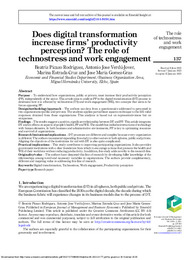Por favor, use este identificador para citar o enlazar este ítem:
https://hdl.handle.net/11000/38190Registro completo de metadatos
| Campo DC | Valor | Lengua/Idioma |
|---|---|---|
| dc.contributor.author | Picazo Rodríguez, Beatriz | - |
| dc.contributor.author | Verdú-Jover, Antonio Jose | - |
| dc.contributor.author | Estrada-Cruz, Marina | - |
| dc.contributor.author | Gomez-Gras, Jose Maria | - |
| dc.contributor.other | Departamentos de la UMH::Estudios Económicos y Financieros | es_ES |
| dc.date.accessioned | 2025-11-14T08:21:16Z | - |
| dc.date.available | 2025-11-14T08:21:16Z | - |
| dc.date.created | 2024 | - |
| dc.identifier.citation | European Journal of Management and Business Economics | es_ES |
| dc.identifier.issn | 2444-8494 | - |
| dc.identifier.issn | 2444-8451 | - |
| dc.identifier.uri | https://hdl.handle.net/11000/38190 | - |
| dc.description.abstract | Purpose To understand how organizations, public or private, must increase their productivity perception (PP), independently of the sector. This article aims to analyze PP in the digital transformation (DT) process to determine how it is affected by technostress (TS) and work engagement (WE), two concepts that seem to be forces opposing PP. Design/methodology/approach The authors use data from a questionnaire addressed to personnel in two organizations (public and private). The analysis applies partial least squares technique to the 505 valid responses obtained from these organizations. This analysis is based not on representativeness but on uniqueness. Findings The results suggest a positive, significant relationship between DT and PP. This article integrates DT and its effects on aspects of people's health, PP and WE. The model thus includes interactions of technology with human elements. In both business and administrative environments, PP is key to optimizing resources and survival of organizations. Research limitations/implications DT processes are different and complex because every organization is different. The authors recommend expanding this study to other sectors in both spheres, public and private. Aligning the objectives of the institutions for aid with DT is also quite complicated. Practical implications This study contributes to improving participating organizations. It also provides government institutions with a clear foundation from which to encourage actions that promote the health and WE of their workforce without reducing productivity. In addition, this study adds novelty to the research line. Originality/value The authors have deepened this line of research by developing fuller knowledge of the relationships among novel and necessary variables in organizations. The authors provide complementary, different and inspiring value in addressing this line of research. | es_ES |
| dc.format | application/pdf | es_ES |
| dc.format.extent | 20 | es_ES |
| dc.language.iso | eng | es_ES |
| dc.publisher | Emerald Publishing | es_ES |
| dc.relation.ispartofseries | 33 | es_ES |
| dc.relation.ispartofseries | 2 | es_ES |
| dc.rights | info:eu-repo/semantics/openAccess | es_ES |
| dc.rights | Attribution-NonCommercial-NoDerivatives 4.0 Internacional | * |
| dc.rights.uri | http://creativecommons.org/licenses/by-nc-nd/4.0/ | * |
| dc.subject | Digital transformation | es_ES |
| dc.subject | Technostress | es_ES |
| dc.subject | Work engagement | es_ES |
| dc.subject | Productivity perception | es_ES |
| dc.subject.other | CDU::3 - Ciencias sociales::33 - Economía | es_ES |
| dc.title | Does digital transformation increase firms' productivity perception? The role of technostress and work engagement | es_ES |
| dc.type | info:eu-repo/semantics/article | es_ES |
| dc.relation.publisherversion | https://doi.org/10.1108/EJMBE-06-2022-0177 | es_ES |

Ver/Abrir:
ejmbe-06-2022-0177.pdf
552,92 kB
Adobe PDF
Compartir:
 La licencia se describe como: Atribución-NonComercial-NoDerivada 4.0 Internacional.
La licencia se describe como: Atribución-NonComercial-NoDerivada 4.0 Internacional.
.png)